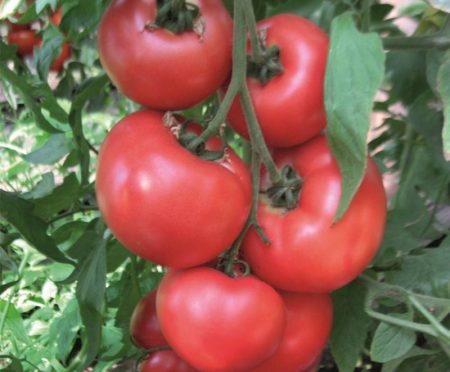
Tomato Fenda is an early ripe hybrid suitable for growing in greenhouses and open soils. Such a variety was bred by French breeders. The tall hybrid boasts high yields and excellent palatability.
Content
Features Fenda Hybrid Characteristics
The height of the bushes reaches 2 meters, in greenhouses the growth is unlimited. The growing season of the variety is 70-80 days. The main stem is straight and strong, the leaf blade is rather large, and the rhizome is well developed.
On one bunch, 6-10 ovaries are formed. Ripe tomato weighs from 250 g to 400 g, the shape of the tomato is rounded with a pink color. The high sugar content gives the fruit a sweet taste with a slight acidity. Inside a dense vegetable there are 6 chambers containing seeds. The pulp is fleshy and juicy.
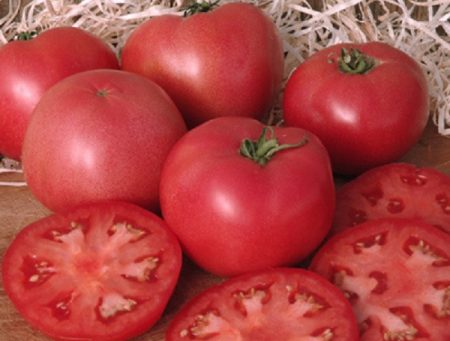
On one plant can be 40-50 pieces of fruit. From one square collect up to 25 kg of tomatoes. Thanks to the early ripening, Fenda can be grown twice a season: from spring to summer, from summer to autumn.
Grade Destinations
Sugar flavor and fleshy pulp are suitable for preparing a variety of tomato sauces, ketchups and juices. Fresh tomatoes are added to salads, canned tomatoes are sliced.
Advantages and disadvantages of the hybrid
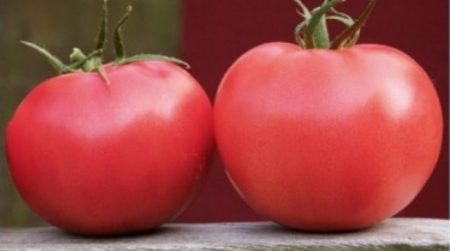
Main advantages:
- tomatoes are transportable;
- the skin is dense, the fruits do not crack;
- bushes can be grown under and without film;
- great taste and attractive appearance;
- the variety is resistant to many diseases.
Disadvantages:
- tall bushes are demanding for constant garter;
- the variety is demanding on top dressing.
Fenda tomato cultivation technology
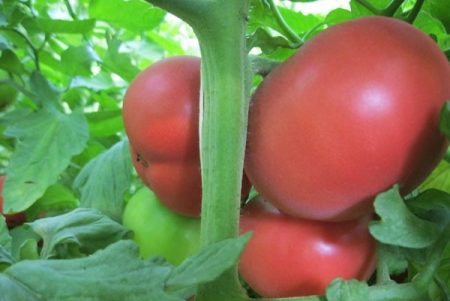
An indeterminate hybrid prefers greenhouse conditions. Seedlings are best sprouted on their own in early spring. Seeds need to be bought from trusted suppliers, and remember to look at the expiration dates on the label. Small and damaged seeds are removed, the rest are dipped in a light manganese solution for 20 minutes, washed and dried a little.
The temperature for sowing should be at least 21-25 degrees. An earth mixture is prepared for seedlings (garden soil, peat and sand: 2: 1: 1), seedlings can be grown in peat tablets.
Seeds are sown in prepared containers, covered with a layer of earth and watered. After the appearance of sprouts (7-10 days), the temperature in the room is reduced to 15 degrees, this is done so that the plant can independently synthesize organic substances from inorganic ones, and also does not go sharply into growth.
After a week, the temperature gradually begins to increase until it reaches 22-24 degrees. The container needs to be moved to a lighted place, if there is not enough light, connect daytime lamps. The earth should be moistened 1-2 times in 7 days.
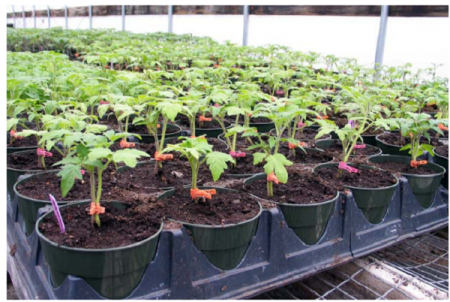
The pick of plants is made in a separate container, when the first leaves appear on the mature seedlings. At the time of transplantation into the garden, plants reach 25-30 cm in height and have about 6-9 leaves. Ovaries form every 5 leaves.
A few days before transplanting seedlings, the soil in the garden should be dug to a depth of 12-14 cm. Complex fertilizers (NPK-15-20 kg / ha) are added to the soil. Seedlings are planted in holes in rows according to the scheme of 50 cm by 40 cm, 3-4 bushes are placed on one square meter.
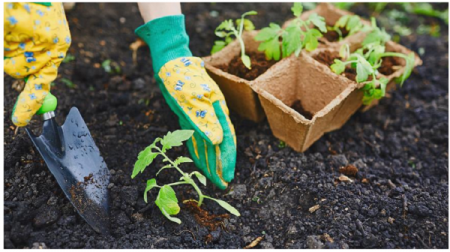
The earth around the holes is compacted and watered, covered with a 10 centimeter layer of mulch on top. For 10 days, seedlings need to be left alone. Bushes are formed in 1-2 stems, with a bush height of 2 meters, at least 8-10 brushes develop on a single specimen. Near the bushes immediately put up a support for the garter.
Features of tomato care
Watering
Every 4-5 days produce moderate watering (500 ml of water per plant), water the bushes under the root in the morning, until the seedlings are taken, the soil moisture should be 80% HB.
Top dressing
A rich tomato crop is achieved with timely top dressing. Potassium supplements synthesize vitamin C, increase root growth and accumulate carbohydrates. Potassium is added during seedling growth, then from the beginning of the formation of the ovaries and during the ripening period.
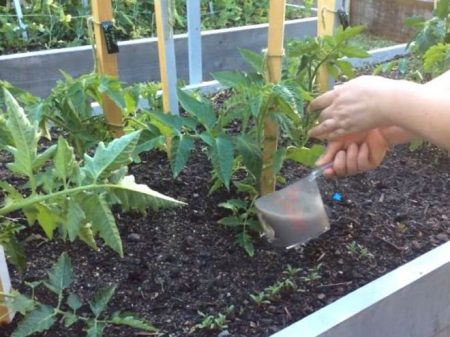
Phosphorus additives (superphosphate, precipitate) are necessary for the ripening of fruits and seeds, add phosphorus twice during the growing season.
Thanks to nitrogen, the plants turn green. But an overdose of nitrogen supplements can lead to the development of abundant foliage, and the plant will not have the strength to bear fruit. Nitrogen (ammonium sulfate, manure, urea, ammonium nitrate) is added twice during the growing season: the first time with the main additives during planting, the second time from the beginning of the formation of the ovaries. Since nitrogen fertilizers make the soil acidic, limestone must be added.
Garter belt
The first tying is done 2 weeks after planting, subsequent garter of the bushes is done every 3 weeks.
We must not forget to weed weeds, clean dry leaves, spray the bushes for the prevention of diseases and pest control.
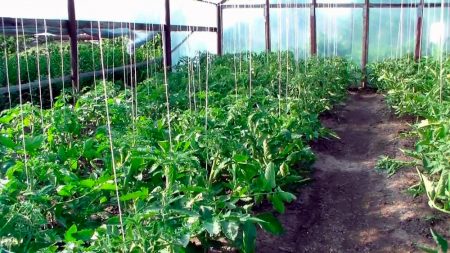
Diseases and pests
With improper and poor-quality care for tomatoes, especially if the humidity of the soil is high, diseases can occur:
- macrosporiosis;
- late blight;
- alternariosis.
Sick plants need to be cleaned and destroyed in order to avoid infection of neighboring bushes. Mineral supplements increase the immunity of tomatoes, and protect the crop from late blight. To overcome pests (dustpan, aphid, Colorado potato beetle), insecticides are used.
What regions are grown
In late April, seedlings are transferred to open soil in the southern and southeastern regions of the Russian Federation; in the western and northwestern regions of the country, tomatoes are planted in greenhouses in early May.
Reviews
Tatyana, Saratov
A beautiful pink tomato variety was grown twice a season. In the second revolution, the fruits ripened until October 20, some still hung green. Tomatoes are very tasty and sweet, some tomatoes turned out with green barrels.
Alexey, Nizhny Novgorod
I love pink varieties of tomatoes. The Fenda variety came to my whole family's taste. The bushes are very high, had to be tied up constantly, but the harvest was good. The wife closed the juices and sauces for the winter.




 Low-growing tomatoes, without pinching: 5 of the most delicious varieties
Low-growing tomatoes, without pinching: 5 of the most delicious varieties Why tomato seedlings grow poorly
Why tomato seedlings grow poorly We grow a tomato in a shell
We grow a tomato in a shell Growing tomatoes without watering according to the method of Kazarin
Growing tomatoes without watering according to the method of Kazarin